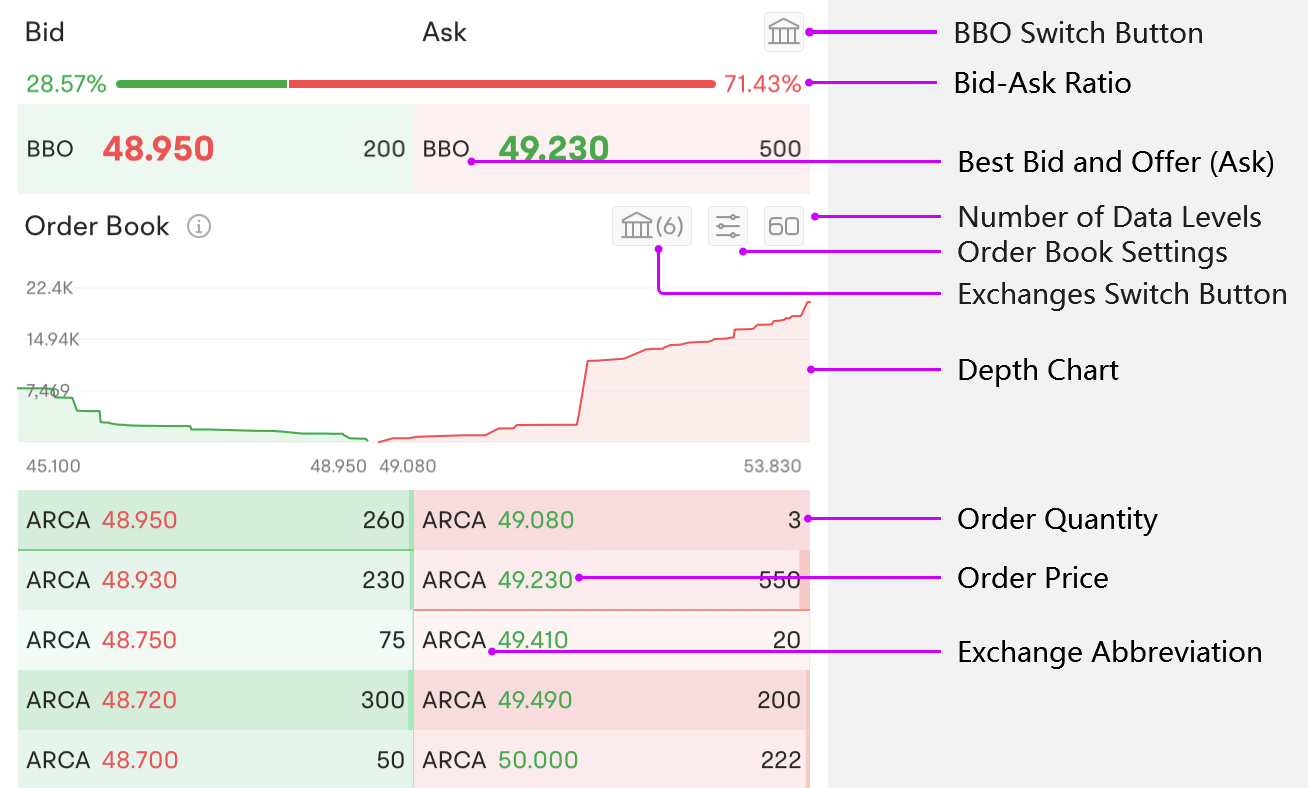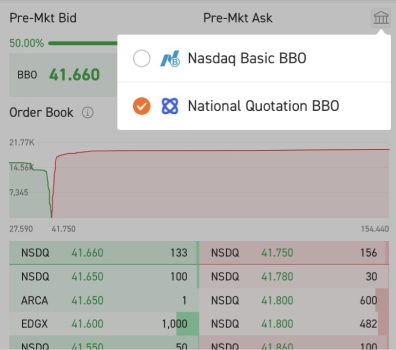- Account
- Funding
- Fee Schedule
- Trading in US Market
- Pattern Day Trading
- Margin Trading
- Cash Sweep
- Stock Transfer
- Trading in HK Market
- Trading in A-shares Market
- Position and P&L
- Promotions
- Free Stocks & Coupons
- IPOs Subscription
- Tax
- Corporate Action
- Getting Started
- App Features
Task Center
Moomoo Badges
Community
Widget
Quotes
Charts
Analysis
Ticks Data & Trade Statistics
What is the P/E ratio and P/B ratio
Top 10 net buy/sell brokers
Financial report
Fiscal Year
Why are the inflows and outflows of stocks not equal
Broker's shareholding ratio-stock analysis
Shareholding ratio of southbound trading
US stocks order book
Company valuation
Trade Overview introduction
How to interpret the "short sale analysis" chart
Market Position Overview
US Stock Analyst Ratings
Pattern
Watchlist
Screener Feature
Alert Feature
Interpretation of indicators
Accessibility Settings
How to export the market data list
How to Fix SSL Connection Errors
Portfolio Introduction
Moomoo premium features
- Market Introduction
- Paper Trading
- Technical Analysis
- Algo Trading
- OpenAPI
- Third-party platform
- Terms and Disclosures
- Contact Us
US stocks order book
1. Overview
1) BBO (Level 1 data) shows the best bid and ask price for security.
2) Order Book (Level 2 data) takes this to the next level by showing market depth or a range of the bid and ask prices, and volumes being traded at each price level.

2. BBO (Level 1 data)
BBO is short for "best bid and offer". Two types of BBOs should be distinguished: NASDAQ BBO and National BBO. You can switch by tapping the small 'house' button on this page.

Comparision of NASDAQ BBO & National BBO:
NASDAQ BBO | National BBO | |
Description | Nasdaq's best quotes | The best quotes among 16 US exchanges |
Data Source | Nasdaq Basic | National LV1 |
Refresh Rate | Real time | Real time |
Share Number Limit | None | At least 100 shares |
Charge | Free | Paid |
3. Order Book (Level 2 data)
3.1 Multiple Order Books
1) Introduction
Moomoo Indepth Order Book consists of data from multiple exchanges and you can select order books from different exchanges as you wish by tapping the small 'house' button.

Comparison of order books of different quotes:
Order Book | NYSE ArcaBook | NYSE OpenBook | NASDAQTotalView | CBOE Direct Edge | CBOE Bats BZX | National Quotation |
Refresh Rate | Real time | Real time | Real time | Real time | Real time | Real time |
Number of data | 60 | 60 | 60 | 60 | 60 | 13 |
Charge | Free during promotion | Paid | Paid | Paid | Paid | Paid |
Supported Exchange | Arca Exchange | NYSE | Nasdaq | Direct Edge | BATS | BBO of 13 Mainstream Exchanges |
U.S. Transaction Volume | About 10% | About 12% | About 18% | About 7% | About 5% | -- |
Pre-Market and Post-MarketOrders | Supported | Pre-market orders will not be matched; Post-marketordersnot supported | Supported | Pre-market orders will not be matched; Post-market orders not supported | Pre-market orders will not be matched; Post-market orders not supported | -- |
New stock bidding to be matched | Not supported | NYSE-listed stocks supported | Nasdaq-listed stocks supported | Not supported | Not supported | -- |
NYSE OpenBook only supports aggregated data. There is no switch for aggregation.
3.2 Price Aggregation
Orders with the same price may occupy several data levels. After Aggregating by price, traders can acquire more data levels and information.
3.3 Depth Chart
1) Introduction
Order books can display orders at each price. However, it is very difficult for investors to quickly grasp the relative strength of buyers and sellers when dozens of orders are displayed. By means of data visualization, we present prices and order quantities in a chart to help investors better understand supply and demand.
2) How to read the chart?
X-Axis indicates the price distribution of all orders
Y-Axis indicates the cumulative order numbers up to or down to a certain price (i.e., the number of orders currently needed to be filled for the stock to reach a certain price level).
Press on the depth chart area and a crosshair will show, which will show the price and cumulative order number of a certain point.

3) Function
Chart height represents the cumulative order number;
Chart width represents the range of price distribution;
Where the line is steep, it indicates that orders are concentrated at certain price level.
4. FAQs
4.1 New requirements to access Level 2 data
Beginning October 21, 2023, there will be changes to Level 2 data (NYSE Arcabook) access on moomoo. After these changes go into effect on October 21, 2023, you will receive complimentary 30-day access to Level 2 data.
For continued access after the complimentary period is over, you will need to maintain a 30-day average account value of $100 or more. (Account value includes uninvested cash and invested values in stocks, ETFs, options, etc.).
4.2 What happens if I don't meet the new requirements?
After this free 30-day access ends, if you don't meet these new account requirements, you will only have access to Level 1 data, which shows the current bid and offer for U.S. stocks. Level 2 data provides multiple levels of bids and offers that have been made for U.S. stocks.
4.3 If my account value dips below $100, do I instantly lose access to Level 2 data?
No. If your account drops below $100, you won't lose access to Level 2 data instantly. However, if your 30-day average account value falls below $100, you will no longer have access to Level 2 data.
4.4 How soon can I get my Level 2 data feature back?
You can get your Level 2 data feature back once your 30-day average account value goes back to $100.
4.5 Does my uninvested cash balance or invested assets count toward this requirement?
Both invested and uninvested assets count. For example, a $100 account balance includes cash, stocks, ETFs, options, etc.
4.6 How to use Level 2 data?
Level 2 data shows market demand (bids on the left) and supply (asks on the right). As Level 2 market data represents orders that are waiting to be executed, it may signal future price movements. A bid for a large number of shares tends to push the stock price higher as it signals higher demand. Conversely, an ask for a large number of shares tends to push the stock price lower as it signals that supply > demand.

4.7 BBO Anomalies
BBO sometimes has an unusual situation where the price of best bid is equal to or higher than the best ask. Details are as follows:
Locked Markets: A situation where the bid and ask prices for a security are identical;
Crossed Markets: A situation where the bid price higher than the ask price;
These unusual circumstances arise as orders are submitted to different exchanges (e.g. NYSE and NASDAQ ) and thus they cannot be matched.
4.8 Listing Day Order Book
On the listing day of a US stock, there will be a period when no orders will be matched (on-site auction period). For stocks listed on NASDAQ, you can view online orders to be matched via NASDAQ TotalView; for stocks listed on the NYSE, you can view via NYSE OpenBook.
4.9 Why there is no data after market close?
The data of order books will be cleared after 0:00 EST and will not be retained.
4.10 Some NYSE OpenBook data appear to be abnormal?
In some instances, NYSE OpenBook data may appear abnormal (i.e. stock prices deviate significantly from their usual or expected levels). There are two reasons why:
a) Pre-market and post-market trading hours: The NYSE does not conduct pre-market matching. Therefore, all NYSE orders in the pre-market period will be displayed in NYSE OpenBook data, but no matchmaking will be performed. There are many abnormal prices in this situation; the buying price may be substantially higher than the selling price. Abnormal prices during pre-market and post-market trading can lead to orders going unfilled, increased volatility, and opportunities for certain types of trading strategies. These periods are often less liquid and can carry higher risks, so investors and traders need to be cautious and understand the unique dynamics of trading outside of regular market hours.
b) Circuit breaker: Circuit breakers function automatically by stopping trading when prices hit predefined levels. When trading is suspended, the exchange will not match trades and crossed or locked markets may rise.
4.11 About MPID (Market Participants ID)
NASDAQ TotalView, NYSE OpenBook, and NYSE ArcaBook are usually displayed as NASDAQ, NYSE, and ARCA respectively, indicating that the orders come from participants in the specific exchange. There are sometimes some other market maker IDs.
4.12 Why does my unfilled order not appear on BBO?
There are two possibilities:
a) The current BBO is provided by another exchange
b) The current BBO is provided by the exchange where your order is received, but the amount of your order is not optimal (need at least 100 shares to appear on BBO).
Risk Disclosure This presentation is for informational and educational use only and is not a recommendation or endorsement of any particular investment or investment strategy. Investment information provided in this content is general in nature, strictly for illustrative purposes, and may not be appropriate for all investors. It is provided without respect to individual investors’ financial sophistication, financial situation, investment objectives, investing time horizon, or risk tolerance. You should consider the appropriateness of this information having regard to your relevant personal circumstances before making any investment decisions. Past investment performance does not indicate or guarantee future success. Returns will vary, and all investments carry risks, including loss of principal. Moomoo makes no representation or warranty as to its adequacy, completeness, accuracy or timeliness for any particular purpose of the above content.